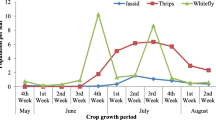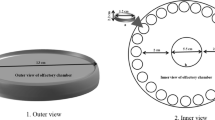Abstract
Ten genotypes of Asiatic cotton, Gossypium arboreum, viz. C-353, G 17, G 33, AC-3545, LD 491, LD 575, B 11 A, SAG-BLY (Red), Sargosi and LD 694, were screened under epiphytotic conditions against spotted bollworm, Earias vittella, at the cotton farm of the Department of Plant Breeding and Genetics, Punjab Agricultural University, Ludhiana, India, and their morphological basis of resistance to spotted bollworm was studied. The plant characters examined were plant color, leaf shape, size and shape of bract, density of gossypol glands, nectaries, hair density and hair length. Hair density was positive (r = 0.81, P = 0.005) and significantly correlated with the number of eggs laid by E. vittella, whereas a significantly negative (r = –0.66, P = 0.038) correlation was obtained with gossypol glands. Similarly, correlation of larval population with hair density was significantly positive (r = 0.68, P = 0.030) and gossypol glands were negative (r = –0.63, P = 0.050) and significantly correlated with larval population. The R2 values, computed together for multiple regression analysis, indicated that the morphological plant traits, viz., gossypol glands and hair density, cumulatively contributed 67% and 50% variability in the egg and larval population, respectively. Genotype B 11 A, with the lowest egg and larval population, had a high number of gossypol glands, low hair density and smaller bracts and proved to be the best, followed by LD 491. Genotypes with low hair density, smaller bracts and a greater number of gossypol glands are desirable for low oviposition and larval population of E. vittella. These characteristics should be taken into consideration when planning a resistance breeding program against spotted bollworm in arboreum cotton.

Similar content being viewed by others
References
Agarwal, R. D., & Katiyar, K. N. (1974). Ovipositional preference and damage by spotted bollworm (Earias fabia Stoll) in cotton. Cotton Development, 4, 28–30.
AICCIP. (2011). All India coordinated cotton improvement project. Annual report 2010-11 (pp. 1–5). Coimbatore, India: Central Institute for Cotton Research, Regional Station.
Bal, H., & Dhawan, A. K. (2008). Arthropod diversity in Bt and non-Bt cotton. Proceedings of 2nd Congress on Insect Science (p. 245). Ludhiana, India: Department of Entomology, Punjab Agricultural University.
Benedict, C. R., Martin, G. S., Liu, J., Puckhaber, L., & Magill, C. W. (2004). Terpenoid aldehyde formation and lysigenous gland storage sites in cotton: Variant with mature glands but suppressed levels of terpenoid aldehydes. Phytochemistry, 65, 1351–1359.
CICR (2011). Glanded and glandless cottons. Technical Bulletin no. 12, Central Institute of Cotton Research, Nagpur, India (www.cicr.org.in).
Dhawan, A. K., Simwat, G. S., & Sidhu, A. S. (1988). Assessment of avoidable loss in cotton (Gossypium hirsutum and Gossypium arboreum) due to sucking pests and bollworms. Indian Journal of Agricultural Sciences, 58, 290–292.
Dongre, T. K., & Rahalkar, G. W. (1980). Growth and development of spotted bollworm, Earias vittella on glanded and glandless cotton and on diet containing gossypol. Entomologia Experimentalis et Applicata, 27, 6–10.
Gupta, B. D. (1978). Differentiation of sex in pupae of the spotted bollworm, Earias fabia (Stoll) (Lepidoptera: Noctuidae-Erastriinae). Current Science, 47, 642.
Hargreaves, H. (1948). List of recorded cotton insects of the world. London, UK: Commonwealth Institute of Entomology.
Kamboj, H. B., & Singh, R. (2002). Effect of morphological variants developed as isolines of cotton on oviposition preference of spotted bollworm. Journal of Cotton Research and Development, 16, 54–58.
Mehta, R. C. (1971). Survival and egg production of cotton spotted bollworm, Earias fabia (Stoll) (Lepidoptera: Noctuidae) in relation to plant infestations. Applied Entomology and Zoology, 6, 206–209.
Mohan, P., Singh, P., Narayanan, S. S., & Ratan, R. (1994). Relation and gossypol gland density with bollworm incidence and yield in tree cotton (Gossypium arboreum). Indian Journal of Agricultural Sciences, 64, 691–696.
Parrott, W. L. (1990). Plant resistance to insects in cotton. Florida Entomologist, 73, 392–396.
Pearson, E. O., & Darling, R. C. M. (1958). Insect pests of cotton in tropical Africa. London, UK: Empire Cotton Growers and Commonwealth Institute of Entomology.
Renwick, J. A. A. (1994). Oviposition behaviour in Lepidoptera. Annual Review of Entomology, 39, 377–400.
Sharma, H. C., & Agarwal, R. A. (1983a). Factors affecting genotypic susceptibility to spotted bollworm Earias vittella Fab. in cotton. International Journal of Tropical Insect Science, 4, 363–372.
Sharma, H. C., & Agarwal, R. A. (1983b). Oviposition behaviour of spotted bollworm, Earias vittella Fab. on some cotton genotypes. International Journal of Tropical Insect Science, 4, 373–376.
Shera, P. S. (2009). Extent of avoidable losses due to spotted bollworms (Earias spp.) in Asiatic cotton Gossypium arboreum L. Pest Management and Economic Zoology, 17, 101–104.
Singh, M., & Lal, C. B. (1984). Basis of resistance to bollworm in desi cotton Gossypium arboreum L. Annals of Agricultural Research, 5, 151–155.
Sundramurthy, V. T., & Chitra, K. (1992). Integrated pest management in cotton. Indian Journal of Plant Protection, 20, 1–17.
Author information
Authors and Affiliations
Corresponding author
Rights and permissions
About this article
Cite this article
Keshav, A., Shera, P.S. & Singh, J. Morphological basis of resistance to spotted bollworm, Earias vittella (Fabricius) in Asiatic cotton. Phytoparasitica 41, 235–240 (2013). https://doi.org/10.1007/s12600-012-0283-8
Received:
Accepted:
Published:
Issue Date:
DOI: https://doi.org/10.1007/s12600-012-0283-8




